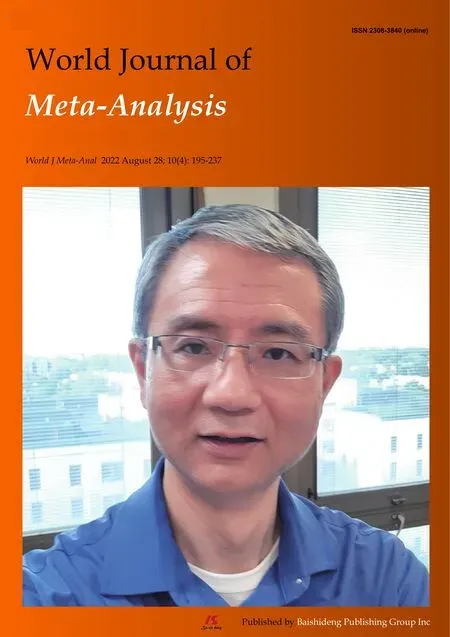Outcomes of microwave versus radiofrequency ablation for hepatocellular carcinoma: A systematic review and meta-analysis
Myo Jin Tang,Guy D Eslick,John S Lubel,Ammar Majeed,Avik Majumdar,William Kemp,Stuart K Roberts
Abstract BACKGROUND Studies to date comparing outcomes of microwave ablation (MWA) with radiofrequency ablation (RFA) on patients with hepatocellular carcinoma have yielded conflicting results, with no clear superiority of one technique over the other. The aim of this systematic review and meta-analysis was to compare the efficacy and safety of MWA with RFA.AIM To perform a systematic review and meta-analysis comparing the efficacy and safety of MWA with RFA.METHODS A systematic literature search was performed using Ovid Medline, Embase, PubMed, Reference Citation Analysis, Cochrane Central and Cochrane Systematic Review databases, and Web of Science. Abstracts and full manuscripts were screened for inclusion utilising predefined inclusion and exclusion criteria comparing outcomes of MWA and RFA. A random-effects model was used for each outcome. Meta-regression analysis was performed to adjust for the difference in follow-up period between the studies. Primary outcome measures included complete ablation (CA) rate, local recurrence rate (LRR), survival [local recurrence-free survival (LRFS), overall survival (OS)] and adverse events.RESULTS A total of 42 published studies [34 cohort and 8 randomised controlled trials (RCT)] with 6719 patients fulfilled the selection criteria. There was no significant difference in tumour size between the treatment groups. CA rates between MWA and RFA groups were similar in prospective cohort studies [odds ratio (OR) 0.95, 95% confidence interval (CI) 0.28-3.23] and RCTs (OR 1.18, 95%CI 0.64-2.18). However, retrospective studies reported higher rates with MWA (OR 1.29, 95%CI 1.06-1.57). Retrospective cohort studies reported higher OS (OR 1.54, 95%CI 1.15-2.05 and lower LRR (OR 0.67, 95%CI 0.51-0.87). No difference in terms of LRFS or 30-d mortality was observed between both arms. MWA had an increased rate of adverse respiratory events when compared to RFA (OR 1.99, 95%CI 1.07-3.71, P = 0.03).CONCLUSION MWA achieves similar CA rates and as good or better longer-term outcomes in relation to LRR and OS compared to RFA. Apart from an increased rate of respiratory events post procedure, MWA is as safe as RFA.
Key Words: Microwave ablation; Radiofrequency ablation; Hepatocellular carcinoma; Survival; Recurrence; Meta-analysis
INTRODUCTION
Hepatocellular carcinoma (HCC) now ranks worldwide as the seventh most common cancer and the second leading cause of cancer mortality[1-3] and is rapidly increasing in incidence in several developed regions including North America, Europe, and Australasia[4-6]. Furthermore, an increasing proportion of HCC patients are being diagnosed at an early stage and are eligible for curative therapy[7,8] including local ablation which is considered standard of care for those not suitable for surgery[9-11].
Of the common modalities used to ablate HCC, radiofrequency ablation (RFA) is the most strongly recommended[12]. This is based on evidence from randomised controlled trials (RCTs)[13-16] and three meta-analyses[17-19] showing that RFA provides better local disease control and overall survival (OS) outcomes than percutaneous ethanol injection, particularly among nonsurgical candidates[20]. Recently, microwave ablation (MWA) has become a popular ablative technique because of its reduction in heatsink effect, ability to produce wider and more predictable ablation volumes that result in high complete ablation rates, and the ability to simultaneously treat multiple and/or larger lesions more effectively and over a shorter procedural time[12,21]. Studies to date comparing outcomes of MWA with RFA have yielded conflicting results, with no clear superiority of one technique over the other[22-24]. A Cochrane review reported that there were insufficient data to recommend RFA over other thermal ablation techniques in the management of HCC[25], with the authors emphasising that only a single small RCT comparing MWA with RFA, with a total of 72 patients, had been performed[23]. Subsequently, a further six RCTs have been performed with the latest meta-analysis only including five RCTs and 21 cohort studies[26]. In this context, additional evidence, particularly from a comprehensive meta-analysis that incorporated all RCTs, and data from large real-world observational cohort studies would provide clinicians with a better understanding of whether the comparative overall efficacy and safety of MWA over RFA supports the current preferential use of MWA for the treatment of early-stage HCC.
This study was a contemporary systematic review and meta-analysis of RCTs and cohort studies to determine whether MWA is equivalent to or more effective than RFA in relation to the primary treatment endpoints of complete ablation (CA), local recurrence rate (LRR), local recurrence-free survival (LRFS), OS, and safety including adverse events.
MATERIALS AND METHODS
Literature search
The Preferred Reporting Items for Systematic reviews and Meta-Analyses (PRISMA) guidelines[27] were followed and the Assessment of Multiple Systematic Reviews (AMSTAR) measurement tool[28] was used to perform this study. A systematic electronic search was conducted independently by two authors in the Ovid Medline, Embase, PubMed, Reference Citation Analysis, Cochrane library databases, and Web of Science was performed from the inception of each until the first week of October 2021 inclusive of the database of articles that were accepted but not yet published, as well as the clinicaltrials.gov website to identify relevant articles for our review (Supplementary Tables 1-5). The search strategy used the search terms “radiofrequency ablation”, “microwave ablation” and “hepatocellular carcinoma” both as exploded medical subject headings where possible, and as text words. In addition, reference lists of relevant articles including recent reviews, and systematic reviews related to locoregional therapy of HCC were searched. Studies were limited to cohort studies and RCTs using appropriate hedges for each database. A search for unpublished literature was also performed.
Eligibility criteria
Studies were included using the following criteria: (1) Patient age ≥ 18 years; (2) diagnosis of HCC by American Association for the Study of Liver Disease imaging criteria[29] or histopathology; (3) HCC of any size; and (4) no evidence of macrovascular invasion or extrahepatic spread. Studies were excluded based on the following criteria: (1) Case series; (2) studies from the same group that contain overlapping patient populations; (3) treatment with any other modality in conjunction with local ablation therapy with microwave ablation or radiofrequency ablation; (4) non-HCC liver cancer; and (5) Studies where treatment was given as a bridge to liver transplantation.
Study outcomes
The primary outcomes of this study were CA, LRR, LRFS, OS and safety including adverse events and complications. CA was defined in studies as the absence of residual HCC on follow-up imaging postablation. LRR was defined in studies as the development of HCC lesions within the same liver segment as the treated tumour on imaging after CA. LRFS was defined as the proportion of patients alive at various timepoints in the absence of any evidence of local recurrence of HCC after treatment. Included studies had to have reported at least one of the primary endpoints as part of an RCT or observational cohort study.
Selection process
The initial literature search was performed independently by two reviewers (MJT and JL) to identify relevant articles based on the above inclusion and exclusion criteria. Where a difference of opinion occurred on the inclusion of studies for the review, consensus agreement was obtainedviaformal discussion between the two reviewers.
Data collection and bias assessment
Included RCTs were assessed for methodological quality and were classified as being of low, high, or unclear risk of bias according to the Jadad scale[30]. Included cohort studies were quality assessed using the Newcastle-Ottawa Scale[31] where a value ≥ 7 qualified the study as high quality. Data were extracted from the selected studies independently using a data extraction form to collect data on the following: (1) Study details (first author, publication year, journal, country, study design, interventions used, intervention group size); (2) baseline participant characteristics (age, sex, and cirrhosis status); (3) tumour characteristics (tumour stage and staging system, largest nodule size, nodule number, alfafetoprotein level, mean-tumour size); (4) intervention details; and (5) outcome measures: (complete ablation, local recurrence rate, overall and local recurrence free survival, adverse events, 30-d mortality).
Statistical analysis
A random-effects model using the method of DerSimonian and Laird was used for each outcome. Metaregression analysis was performed to adjust for the difference in follow-up period between the studies.
Analysis was also performed individually for RCTs, prospective and retrospective cohort studies. Heterogeneity was assessed using theI² statistic with results of 30%-60% (moderate), and > 50% (high) levels of heterogeneity[32]. Outcomes were reported using a pooled odds ratio (OR) and hazard ratio (HR) with 95% confidence interval (CI). We assessed publication bias using the Egger’s regression model only if there were > 10 studies. All analyses were performed with Comprehensive Meta-analysis (version 3.0), Biostat, Englewood, NJ (2014). The statistical methods of this study were reviewed by academic statistician Guy Eslick from Clued Ptd Ltd.
RESULTS
Study selection and characteristics of included studies
As shown in Figure 1, the search strategy utilised for this meta-analysis identified 2758 studies initially. After removing duplicates and excluding studies based on our inclusion and exclusion criteria, 170 studies were assessed for eligibility from which a total of 42 studies, eight RCTs[22,23,33-38] and 34 cohort studies[33,39-71] were finally included in the meta-analysis. The main characteristics of included studies are reported in Table 1. The sample size of included studies (eight RCTs and 34 cohort studies) ranged from 42 to 879, with males forming the majority. In total, we examined a cohort of 6719 patients. A total of 24 studies were conducted in Asia, nine in Europe, five in Egypt, two in the USA, and one each in Australia and Turkey. Study follow-up duration ranged from 3 to 126 mo and was performed through the utilisation of computed tomography or magnetic resonance imaging. Across all studies, the mean age reported was 61 years. Most studies recruited patients with Child-Pugh stage A and B liver disease with only one RCT and nine cohort studies recruiting stage C patients. Notably, all 42 studies were comparable with regards to clinical and tumoral parameters. Maximum nodule sized ranged from 9 to 55 mm in RCTs and 8 to 60 mm in cohort studies. In total, six RCTs and 18 cohort studies reported mean tumour size. There was no significant difference in tumour size treated with MWA compared to RFA in both RCTs (OR 1.13, 95%CI 0.88-1.46) and cohort studies (OR 0.96, 95%CI 0.77-1.20) (Supplementary Figure 1). Furthermore, there was no significant difference in mean tumour size amongst RCTs (OR 0.05, 95%CI -0.07 to 0.18;P= 0.395) and cohort studies (OR -0.01, 95%CI -0.09 to 0.07;P= 0.777) (Supplementary Figure 2). The total number of lesions treated per study with MWA and RFA ranged from 15 to 1090 and 20 to 562, respectively.
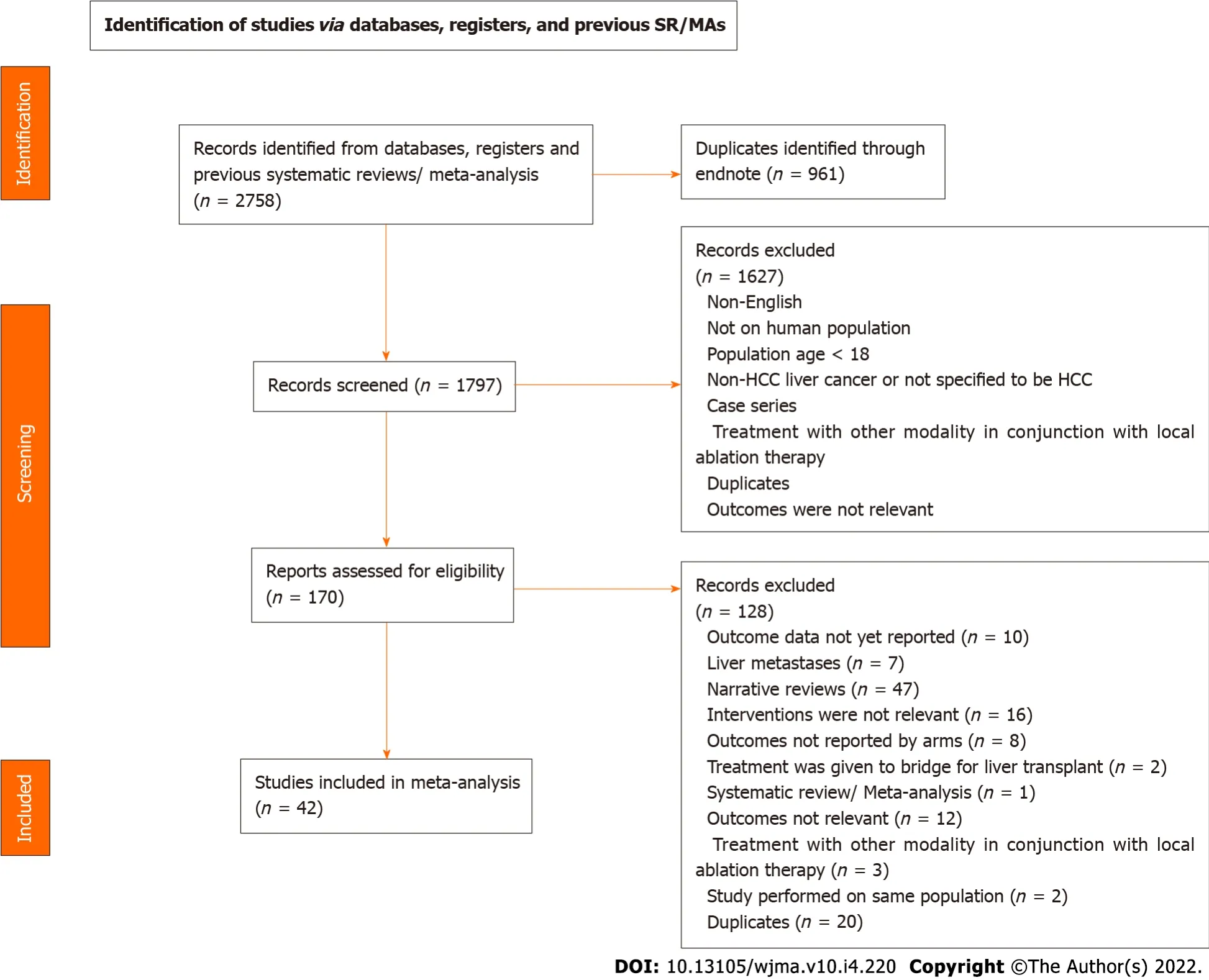
Figure 1 Flowchart of search strategy and article screening process.

Table 1 Summary of patient characteristics of included randomised controlled trials and cohort studies
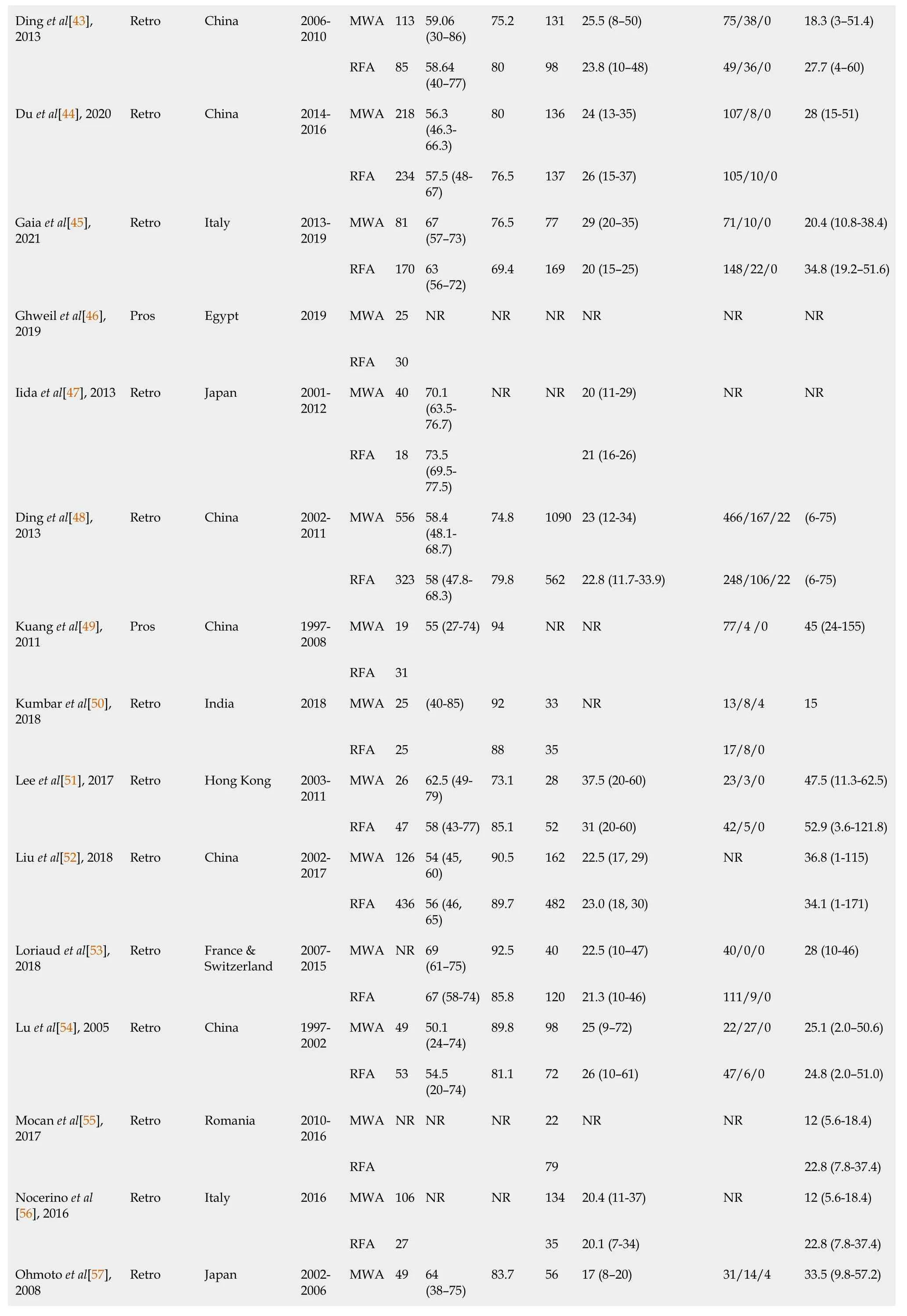


CPC: Child Pugh Score; MWA: Microwave ablation; NP: Number of patients; NL: Number of lesions, NR: Not reported; RFA: Radiofrequency ablation.
Quality assessment
Seven of the eight RCTs assessed were deemed to be high quality with one study[22] deemed to be of low quality (Supplementary Table 6). All RCTs were determined to be at high risk of performance bias as it was not practical to blind the administrator to the procedure. However, four RCTs[23,34,37,38] were able to blind the outcome of assessment. Potential for selection and detection bias was identified in four RCTs[22,35,36,72]. Of the 34 cohort studies identified, 30 scored a value of 7 or higher, meeting the definition of a high-quality study (Supplementary Table 7).
CA
Seven RCTs[22,23,34-37,72] and 24 cohort studies[39,42-46,48-51,54,55,60-71] reported data on CA posttreatment. No significant difference in the CA rate was found between the MWA and RFA groups in the prospective cohort studies (OR 0.95, 95%CI 0.28-3.23;P= 0.82)[41,46,49,59,71] and RCTs (OR 1.18, 95%CI 0.64-2.18;P= 0.60)[22,23,34-37,72]. However, retrospective cohort studies reported higher CA rates with MWA compared to RFA (OR 1.29, 95%CI 1.06-1.57;P= 0.01) (Figure 2A)[39,42-45,48,50,51,54,55,60-70]. No evidence of heterogeneity was found in these studies (P= 0.99). Funnel plot analysis concluded that publication bias was unlikely (Figure 2B).
OS
Five RCTs[22,34,35,38,72] and 17 cohort studies[33,41,43,47,51,52,54,57,59-63,66,68,70,71] reported data on OS post-ablation (Table 2). Heterogeneity was identified in the results reported at 3 and 4 years by retrospective cohort studies (Table 2)[33,43,51,52,54,57,66,68,70]. In studies that categorised data into OS into specific years, no significant difference in OS was noted between MWA and RFA groups. Metaanalysis of four retrospective studies that did not specify the follow-up period[52,54,59,63] reported significantly higher OS in patients treated with MWA. No potential bias was identified during visual assessment and Egger’s test of funnel plot.
Individual study OS rates were plotted on a dot graph for both MWA and RFA treated subjects (Figure 3) with median OS rates according to year of follow-up post-treatment shown in Table 3. Of note, MWA was associated with improved median OS at 3 and 4 years of follow-up but this difference was lost at 5 years.
LRR
Six RCTs[22,23,35,36,38,72] and 26 cohort studies[39-41,43,44,46,47,49,51-58,60,61,63-70] reported data regarding LRR following ablation (Table 2). One RCT[22] reported lower 5-year LRR when patients were treated with MWA (OR 0.52, 95%CI 0.30-0.91;P= 0.023). Heterogeneity was identified in the results reported at 1, 2 and 3 years by retrospective cohort studies while meta-analysis of two retrospective cohort studies[53,57] reported a higher 4-year LRR in patients treated with MWA (OR 2.14, 95%CI 1.12-4.07,P= 0.021) (Table 2). However, meta-analysis of 20 retrospective cohort studies that reported LRR over an unspecified period[39-41,43,44,46,52-54,56-58,60,63,65-70] concluded that LRR was significantly lower in patients treated with MWA (OR 0.67, 95%CI 0.51-0.87,P= 0.002). Three cohort studies reported LRR according to tumour size ≤ 3 cm[43,52,54] with no statistcally significant differences identified between the MWA and RFA groups (OR 0.86, 95%CI 0.45-1.64,P= 0.64). No potential bias was identified during visual assessment and Egger’s test of funnel plot.
HR for OS and LRR
Four RCTs[22,34,38,72] and 18 cohort studies[39,41,43-45,51-53,57-61,64,66,68,70] reported HR data regarding OS (Table 4). No significant differences were noted in OS between both arms. However, there was a trend towards better OS rates in patients treated with MWA in both RCTs (P= 0.08) and prospective cohort studies (P= 0.08) over an unspecified period (Table 4). Five retrospective cohort studies reported HR data regarding LRR[39,53,58,61,64]. No significant differences were noted in LRR between both arms. No potential bias was identified during visual assessment and Egger’s test of funnel plot.
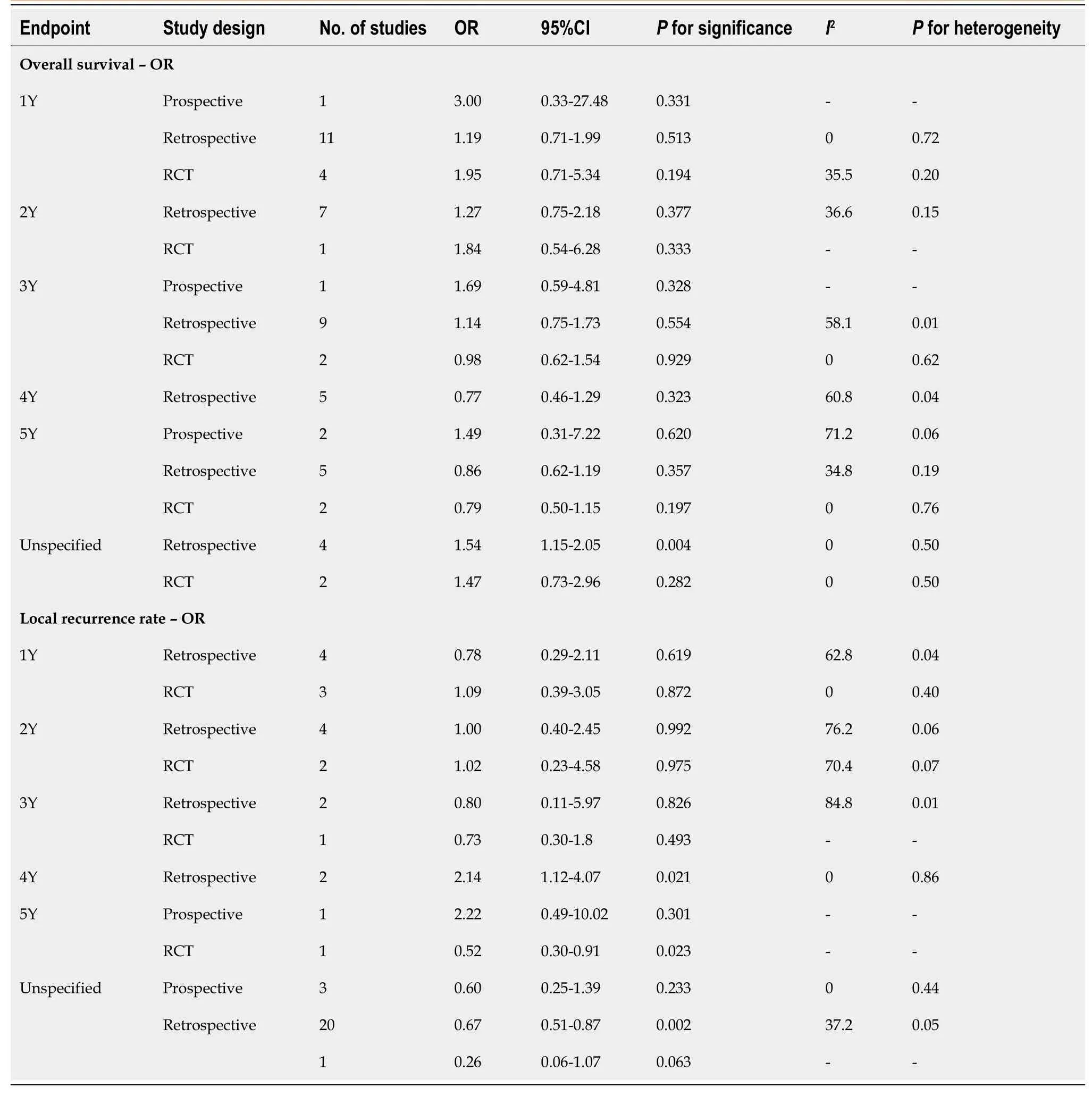
Table 2 Summary of the comparison of OS and local recurrence rates between microwave ablation versus radiofrequency ablation for intrahepatic hepatocellular lesions in both cohort studies and RCTs according to year of follow-up

Table 3 Summary of the comparison of median and mean overall survival rates between microwave ablation versus radiofrequency ablation for intrahepatic hepatocellular carcinoma lesions in both cohort studies and randomised controlled trials

Table 4 Summary of overall survival and local recurrence rate HRs

Table 5 Microwave ablation versus radiofrequency ablation for hepatocellular lesions: Meta-analysis of adverse events
LRFS
One RCT[35] reported that there was no significant difference between MWA and RFA with regards to 1-year LRFS (OR 1.175, 95%CI 0.178-7.737,P= 0.93). One cohort study[63] reported that there was no significant difference between MWA and RFA with regards to LRFS (OR 0.53, 95%CI 0.148-1.86).
Safety
Three RCTs[34,35,38] and 14 cohort studies[33,39,47,48,51,58,60,62-64,67-70] reported data regarding 30-d mortality (Figure 4). No significant differences were identified between the MWA and RFA groups in both RCTs (OR 1.00, 95%CI 0.19-5.14,P= 1.0) and cohort studies (OR 0.67, 95%CI 0.27-1.68,P= 0.39). There was no heterogeneity identified between studies. A sensitivity analysis excluding studies that reported no deaths in both arms was performed (Figure 4), but results remained consistent with the main analysis (OR 0.61, 95%CI 0.25-1.51,P= 0.29). No potential bias was identified during visual assessment and Egger’s test of funnel plot.

Figure 2 Forest plot and funnel plot. A: Microwave ablation versus radiofrequency ablation for intrahepatic hepatocellular carcinoma lesions.Forest plot for complete ablation;B: Microwave ablation versus radiofrequency ablation for intrahepatic hepatocellular carcinoma lesions: Funnel plot for publication bias.
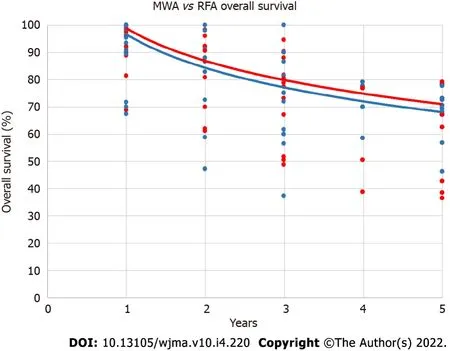
Figure 3 Dot plot of microwave ablation versus radiofrequency ablation overall survival rates over time.Trendlines are based on median survival.Microwave ablation is represented by red dots and red trendline while radiofrequency ablation is represented by blue dots and blue trendline.MWA:Microwave ablation;RFA: Radiofrequency ablation.

Figure 4 Microwave ablation versus radiofrequency ablation for intrahepatic hepatocellular carcinoma lesions: Forest plot for 30-d mortality.
With regard to morbidity, five RCTs[23,35,36,38,72] and 20 cohort studies[33,39,43,44,47-49,51,52,54,57,58,60,61,63-66,68,70] reported data on adverse events (Table 5). There were no significant differences in rates of liver-related morbidity, postprocedural bleeding and infections, local events, and bile duct injury when comparing the two interventions. MWA had a significantly increased rate of adverse respiratory events when compared to RFA (OR 1.99, 95%CI 1.07-3.71,P= 0.03). No potential bias was identified during visual assessment and Egger’s test of funnel plot.
DISCUSSION
Local thermal ablation is the standard of care for patients with unresectable early-stage HCC. MWA is increasingly preferred to RFA because of its ability to produce wider and more predictable ablation volumes over a shorter procedural time[17,19,22]. Moreover, MWA has theoretical advantages including minimising heat-sink effect that limits the use of RFA to lesions with proximity to adjacent structures. To our knowledge, our study is the most detailed systematic review and meta-analysis to date having identified 42 studies including eight RCT’s and 34 cohort studies involving a total of 6719 subjects, that compared the outcomes of the two treatment modalities. Our main findings were that MWA achieves similar complete ablation rates compared with RFA, as well as lower LRR and similar OS. However, adverse events associated with MWA appear higher, particularly in relation to procedure-related respiratory events.
In our study, we found MWA achieved similar or better CA rates than RFA depending on the study design. Notably CA rates were similar between the two modalities among RCTs, as previously reported[73,74], as well as among prospective cohort studies. However, higher CA rates were associated with MWA among retrospective cohort studies, which was likely due to multiple factors including patient selection, tumour size and the technique used; notwithstanding the fact that nearly threefold more cohort studies were captured in our study compared to other smaller meta-analyses of this type[24,40,73]. These findings align with preclinical data that MWA results in higher intratumoral temperature and greater ablation range[75], that should in theory lead to faster ablation times and high rates of CA[76].
In addition, we identified MWA utilisation was overall associated with similar rates of local recurrence to RFA among RCTs and prospective cohort studies. However lower recurrence rates with MWA were reported among retrospective cohort studies, although results were inconsistent with two retrospective cohort studies reporting lower rates of local recurrence with RFA at the 4-year mark, while one RCT reported lower rates of LRR with MWA at the 5-year mark[22,53,54]. Moreover, because this was an analysis of LRR data without a specific timeframe, caution should be exercised as the follow-up for individual studies varied. Potential reasons for discordance in results include the fact that different generators were among studies as well as variation in the reporting outcomes with some studies reporting cumulative LRR. Notably, previous meta-analyses evaluating MWA and LRR have also drawn different conclusions, with two reports concluding that MWA resulted in significantly lower LRR[73,77], while a more recent study found no difference between both interventions[74]. These data combined with ours point to the fact that LRRs following MWA of HCC are at least as good as that following RFA.
An important finding from our study was the identification that MWA appears to lead to better OS, particularly among retrospective cohort studies. However, because this was mainly among studies with no specified follow-up period, we were unable to determine the timeframe to which the improvement in OS applies. Still, median OS rates tend to favour MWA particularly within the first few years postablation. Previous meta-analyses found that up until the 5-year mark, there was no difference between OS rates[24,40,73,74,77]. Except for Huo and colleagues[24]], these meta-analysis did not look at yearly OS. Long-term OS could be affected by interventional factors such as frequency, duration, and power of the ablative machines used. Furthermore, patient factors such as age, pre-existing liver disease and severity, and socioeconomic status could all contribute to OS. As we were unable to account for all these potentially confounding factors, it raises the question whether our results can be applied to the clinical setting with certainty.
In relation to adverse events, previous meta-analyses have concluded that there was no difference in complication rates between both interventions[24,73,74]. In our study, we identified a significantly increased rate of adverse respiratory events (i.e.,pleural effusion and pneumothorax) associated with MWA in 14 studies but no significant differences in local and/or liver related complications. This novel finding could influence the current perception that MWA has a similar safety profile to that of RFA despite the larger ablation zone. One possible explanation of the presence of pleural effusions could be due to thermal injury to the diaphragm resulting in an inflammatory response and/or diaphragmatic microperforations resulting in leakage of fluid from the peritoneal cavity to the pleural space. Similarly, the increased rates of pneumothorax could reflect inadvertent pleural puncture with subsequent air leakage into the pleural space. Ultimately, this novel safety finding adds a layer of complexity when making the decision to choose between MWA or RFA for ablating HCC.
The strengths of our study included it being, to our knowledge, the most comprehensive study on this topic to date. We examined a large cohort of 6719 patients that enabled us to identify outliers and provide results with a smaller margin of error. In addition, data were categorised based on follow-up period, allowing us to identify if the difference between our primary outcomes for each individual year was significant. Finally, an analysis of tumour size was performed ruling out a potential confounding factor. Nevertheless, our findings should be interpreted with caution in view of certain limitations. Firstly, only studies published in English were included, which could lead to selection bias. Secondly, we did not explore the influence of generators and antennas used to perform the procedures which could present as a confounding factor. Furthermore, although we had a significant number of RCTs, the majority of studies were retrospective cohort studies that are susceptible to both selection bias and information bias due to the difficulty in achieving accurate record keeping and recounts of events, as well as complete data retrieval. Conference abstracts were included in our study which allowed for a more comprehensive look at the subject matter but potentially at the cost of preliminary results. Also, a significant number of studies included were conducted by a single centre, and hence subject to patient selection bias. Moreover, eligibility criteria for inclusion of patients were not standardized among studies.
CONCLUSION
Our results suggest that compared to RFA, MWA achieves similar CA rates and as good or better longer-term outcomes in relation to LRR and OS. Our analysis of tumour size suggests that it is unlikely to affect our conclusion. Apart from an increased likelihood of postprocedural respiratory events, MWA is as safe as RFA. Current guidelines recommend RFA to bridge transplantation or in early HCC[10,78]. Our novel results suggest that all guidelines should consider these ablative techniques as being interchangeable as standard of care.
ARTICLE HIGHLIGHTS
Research background
Hepatocellular carcinoma (HCC) is the seventh most common cancer and second leading cause of cancer mortality.Of the common modalities used to ablate HCC,radiofrequency ablation (RFA) is the most strongly recommended.Recently,microwave ablation (MWA) has become a popular ablative technique because of its reduction in heat-sink effect,ability to produce wider and more predictable ablation volumes.
Research motivation
Studies to date comparing outcomes of MWA with RFA have yielded conflicting results,with no clear superiority of one technique over the other.In this context,additional evidence particularly from a comprehensive meta-analysis that incorporate all RCTs and data from large real-world observational cohort studies would provide clinicians with a better understanding.
Research objectives
This study was a contemporary systematic review and meta-analysis of RCTs and cohort studies to determine whether MWA is equivalent to or more effective than RFA in relation to the primary treatment endpoints of complete ablation (CA),local recurrence rate (LRR),local recurrence-free survival,overall survival (OS),and safety including adverse events.
Research methods
A systematic electronic search was conducted independently by two authors.Quality of included studies were assessed using the Jadad scale for RCTs and Newcastle-Ottawa Scale for cohort studies.A random-effects model using the method of DerSimonian and Laird was used for each outcome.Metaregression analysis was performed to adjust for the difference in follow-up period between the studies.
Research results
A total of 42 studies,eight RCTs and 34 cohort studies were included in the meta-analysis,allowing us to examine a total cohort of 6719 patients.CA rates between MWA and RFA groups were similar in prospective cohort and RCTs;however,retrospective studies reported higher rates with MWA.Retrospective cohort studies reported higher OS and lower LRR.MWA had an increased rate of adverse respiratory events when compared to RFA.
Research conclusions
MWA achieves similar CA rates and as good or better longer-term outcomes in relation to LRR and OS compared to RFA.Apart from an increased rate of respiratory events post procedure,MWA is as safe as RFA.
Research perspectives
Current literature on local recurrence free survival is lacking and has potential to be explored in future studies.
FOOTNOTES
Author contributions:Tang MJ performed the systematic review, acquisition and interpretation of the data, drafting the article, and final approval; Eslick GD performed the statistical analysis and interpretation of the data, drafting the article, and final approval; Lubel JS performed the systematic review, acquisition and interpretation of the data, drafting the article, and final approval; Majeed A performed interpretation of the data, review of the article, and final approval; Majumdar A contributed to the study design, interpretation of the data, review of the article, and final approval; Kemp W contributed to study concept and design, interpretation of the data, drafting and review of the article, and final approval; Roberts SK contributed to study concept and design, interpretation of the data, drafting and review of the article, and final approval.
Conflict-of-interest statement:All the authors declare that they have no conflict of interest.
PRISMA 2009 Checklist statement:The authors have read the PRISMA 2009 Checklist, and the manuscript was prepared and revised according to the PRISMA 2009 checklist.
Open-Access:This article is an open-access article that was selected by an in-house editor and fully peer-reviewed by external reviewers. It is distributed in accordance with the Creative Commons Attribution NonCommercial (CC BYNC 4.0) license, which permits others to distribute, remix, adapt, build upon this work non-commercially, and license their derivative works on different terms, provided the original work is properly cited and the use is noncommercial. See: https://creativecommons.org/Licenses/by-nc/4.0/
Country/Territory of origin:Australia
ORCID number:Guy D Eslick 0000-0002-0098-1705; John S Lubel 0000-0003-0828-0572; Ammar Majeed 0000-0002-7024-8787; William Kemp 0000-0002-1891-4578; Stuart K Roberts 0000-0002-9015-7997.
Corresponding Author's Membership in Professional Societies:American Association for the Study of Liver Diseases, No. 1938; European Association for Study of the Liver, No. 11375; Gastroenterology Society of Australia, No. 525; American Gastroenterological Association, No. 100307.
S-Editor:Liu JH
L-Editor:Kerr C
P-Editor:Liu JH

